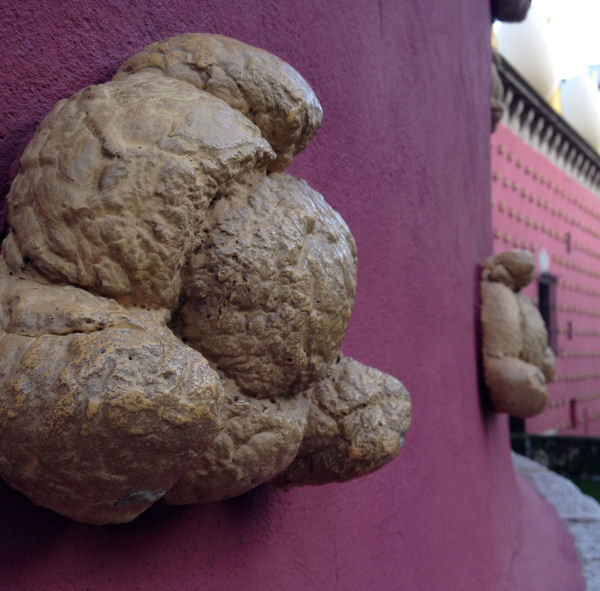One of best-known personalities from the Costa Brava is the great surrealist Salvador Dalí. He was born Figueres in 1904, where a museum dedicated to his work remains one of the biggest draws in the area, and spent many happy summers as a boy with his family in Cadaqués.

If you’re interested in surrealism or Dalí then the Figueres museum is a must. However, there are several other places related to Dalí open to the public and they are all worthwhile visiting if you happen to be staying in the area, or have a particular fascination for the man and his work. We cover them all in the article that follows.
Teatre-Museu Dalí in Figueres
One of the most striking buildings in Figueres is the Teatre-Museu Dalí, which houses the largest and most diverse single collection of the surrealist’s works.
From a distance you can see the large geodesic dome on top but only when you begin to approach the building do you see that much of it appears to be decorated with loaves of a local bread, while instead of turrets it is has large eggs. This is certainly no ordinary museum.
The museum is situated in what was originally the town’s theatre and adjoining buildings; the theatre was among the first venues to publicly display the young artist’s work prior to the Spanish Civil War.
Badly damaged by a fire towards the end of the Spanish Civil War, which resulted in the collapse of the ceiling, the main structure survived mainly intact leaving a shell. It remained in this condition until 1961 when the town’s mayor proposed to Dalí that it be reconstructed and opened as a museum of his work.
Excited by the idea, Dalí was closely involved in its design until opening in 1974 and the decade that followed during which time it continued to evolve.
Although I haven’t been to the museum now for many years, it is certainly interesting to see many of his works and perhaps gaining an insight into his mind, however eccentric, absurd, crazy, genius or paranoid it really was. If the border between genius and insanity is small then Dalí showed it in buckets.
Some of his works I don’t care for at all, preferring his meticulous paintings that are full of detail but include things that are strikingly out of place; desertscapes with a red line running into the sky, for instance, which occurs in a series of paintings.
Sometimes works can be out on loan to exhibitions, which can be a little frustrating if it is something you particularly wanted to see, but there are a number of permanent items, such as the car in the central courtyard; the room with a sofa modelled on Mae West’s lips; and the fresco painted ceilings of some of the rooms. And there is also the crypt, where Dalí is buried.
As well as the main collection, more recently a permanent collection of jewellery design by Dalí between 1941 and 1970 has been added in a building next door. The Dalí·Joies exhibition has its own entrance and can therefore be visited separately from the museum.
Dalí’s house in Portlligat

Dalí first stayed in Portlligat in the summer of 1930, when he rented a fisherman’s cottage with Gala, his muse who some years later he married. Later he bought the cottage and over the next four decades continued to enlarge the cottage into what became a comfortable villa where he lived and worked. He also added egg decorations, like the museum in Figueres, although I don’t know which came first.
He loved Portlligat because of the light, the isolation and the landscape and indeed, some of his paintings feature the volcanic rock formations so typical of the Cap de Creus, grey and full of Swiss cheese holes into which sometimes he added ants.
And some of his most famous paintings were inspired by particular rock formations that remain today, such as seen in The Great Masturbator and The Persistence of Memory, one of his best known paintings featuring ‘soft clocks’.
Dalí lived at this house until the death of Gala in 1982, after which he moved to the castle at Púbol.
Púbol Castle
The Castell Gala Dalí de Púbol can be traced in documents backed to the 11th century, although the structure as it exists today dates from the 14th and 15th centuries. Dalí bought the castle in 1969 in quite a derelict state with collapsed ceilings, serious structural problems and an overgrown garden. The couple restored the castle sympathetically and the interior is decorated in baroque style.
Dalí dedicated the castle to Gala, and indeed, she is buried there after her death in 1982. The artist lived in the castle following her death until 1984, when a fire broke out in his bedroom; after this he friends and admirers moved him to the museum in Figueres.
Above: the locations of the three Salvador Dalí museumsBooking tickets
If you’re planning to visit between mid-July until the end of August as the queues can snake around the block so you’re better off booking tickets in advance.
The house at Portlligat can only be visited with an advance reservation and is closed from mid January until early February.
Púbol Castle is open from March until the end of December.
Guided tours
You can book a guided tour of the Dalí museum in Figueres and skip the queues by booking here.
Or if you’re staying in Barcelona you can take a full day to tour the museums at Figueres and Portlligat with transport included here.


